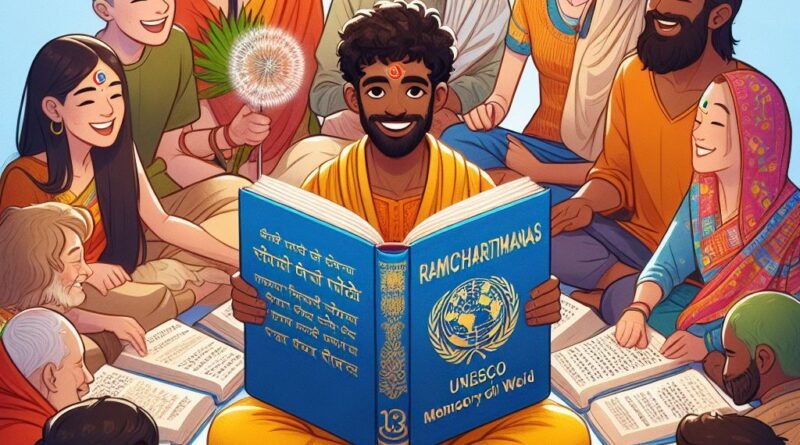Ramcharitmanas Included in UNESCO’s Memory |Ias Banenge
Introduction
India’s rich literary tradition has always been a cornerstone of its cultural identity. Recently, three Indian literary masterpieces—Ramcharitmanas, Panchatantra, and Sahṛdayaloka-Locana—were honored by being added to UNESCO’s Memory of the World Asia-Pacific Regional Register.
This blog explores the significance of these works, the Memory of the World (MOW) program, and other notable inclusions from this year’s register.
READ MORE- Supreme Court Orders Closure of Mines Near Sariska Tiger Reserve
Significance of the Works
Ramcharitmanas
Ramcharitmanas, composed by Goswami Tulsidas in the 16th century, is an epic retelling of the Ramayana in Awadhi dialect. It holds a special place in the hearts of millions in India and Southeast Asia, including countries like Cambodia, Thailand, Sri Lanka, and Indonesia.
The inclusion of Ramcharitmanas in the register underscores its wide-ranging influence and enduring appeal.
Highlights:
- Two manuscripts were nominated: one by Tulsidas and an 18th-century Arabic version.
- The work’s narratives have transcended geographical boundaries, impacting cultures far beyond India.
Panchatantra
Panchatantra, a collection of ancient Indian fables attributed to Vishnu Sharma, imparts universal moral values through its engaging animal stories.
Written around the 3rd century BCE, its tales have been translated into numerous languages, influencing literature globally.
Highlights:
- Known for its timeless wisdom and moral lessons.
- Adapted and retold across various cultures and languages.
Sahṛdayaloka-Locana
Sahṛdayaloka-Locana, authored by Kashmiri scholars Acharya Anandvardhan and Abhinavagupta in the 15th century, is a significant work in Indian aesthetics. It provides insights into the principles of rasa (emotional aesthetics) and the critical appreciation of art and literature.
Highlights:
- Esteemed for its contribution to Indian aesthetic theory.
- Reflects the intellectual and cultural richness of Kashmir.
The Memory of the World (MOW) Register
What is the MOW Register?
UNESCO’s MOW program, initiated in 1992, aims to safeguard and promote documentary heritage that is rare and endangered. The program recognizes works of international, regional, and national significance, ensuring their preservation and accessibility.
Key Objectives:
- Protecting invaluable archive holdings and library collections.
- Raising awareness and facilitating research, education, and preservation.
- Promoting global cultural heritage and preventing collective amnesia.
How the Register Works
The MOW Register operates at international and regional levels. The Asia-Pacific Regional Register (MOWCAP) celebrates the documentary heritage of the region, with recent inscriptions showcasing significant achievements in genealogy, literature, and science.
Other Notable Inclusions in the 2024 Cycle
During the tenth General Meeting of MOWCAP in Ulaanbaatar, Mongolia, 20 new items were added to the register. Some notable entries include:
- China: Documents on tea-drinking business entrepreneurship.
- Indonesia: Research on sugar and regional cement production.
- Philippines: Indigenous Hinilawod chants.
- Bangladesh: Sci-fi feminist work “Sultana’s Dream” by Rokeya S Hossain.
- Australia and Tuvalu: Documentation on coral reef formation research.
Summary in Pointers
- Ramcharitmanas: Epic work by Tulsidas, widely read across South and Southeast Asia.
- Panchatantra: Ancient Indian fables imparting moral values, influential globally.
- Sahṛdayaloka-Locana: Kashmiri work on aesthetics by Acharya Anandvardhan and Abhinavagupta.
- MOW Program: UNESCO initiative to safeguard rare and endangered documentary heritage.
- 2024 MOWCAP Inclusions: 20 new items, celebrating achievements in literature, science, and cultural practices.
Conclusion
The inclusion of Ramcharitmanas, Panchatantra, and Sahṛdayaloka-Locana in UNESCO’s Memory of the World Register is a proud moment for India, reflecting the timeless value and global influence of its literary heritage. This recognition not only celebrates these works but also underscores the importance of preserving and promoting cultural and documentary heritage worldwide.




